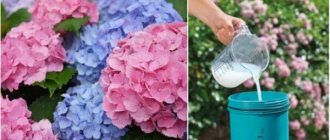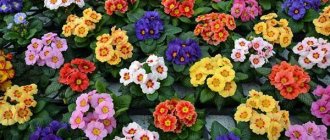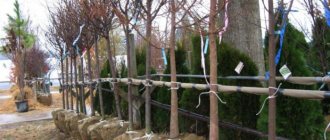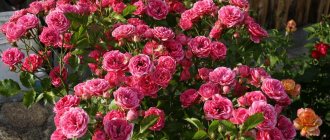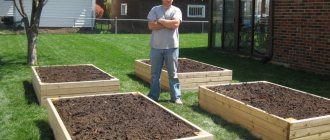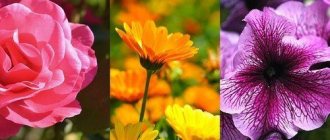Feeding garden trees in spring
Melt water after snow melts washes away useful substances from the soil. Nitrogen compounds are most susceptible to leaching. Therefore, the first spring feeding should contain fertilizers with nitrogen.
To water the soil around the trunk, use the following combinations:
- 50 g of urea, pigeon or chicken droppings, or ammonium nitrate per 1 liter of water. To water 1 tree you need about 5 liters of solution.
- 2.5 kg of manure per bucket of water. To water 1 tree, 2 liters of solution are consumed.
Watering should be done before flowering, approximately 14-20 days.
Another way to feed trees is to spray. This method is also called foliar. To prepare the liquid, you will need urea dissolved in water in different concentrations for certain types of trees:
- 0.3% - for apple trees;
- 0.2% - for pears;
- 0.5% - for cherries, apricots, cherry plums, plums and other stone fruits.
Features of spring feeding of fruit trees
Almost all types of fruit trees are severely depleted after wintering. This can be seen even by their appearance. The worse the condition of the bark, shoots and crown, the greater the trees' need for fertilizer.
Important!
If the spring is rainy, this negatively affects the condition of the soil. After all, all the nutrients necessary for plant growth are washed out of it. They especially need nitrogen at this time, so nitrogen-containing fertilizers should be used for feeding.
When performing spring fertilizing, it is necessary to comply with the timing of its implementation. This should be done 15-20 days before flowering or after the petals fall. To create a nutrient solution you need:
- manure;
- bird droppings;
- urea;
- ammonium nitrate.
All these elements dissolve in warm water in a ratio of 1 to 20. The total volume of fertilizer is calculated based on the fact that about 200 ml of solution is required per square meter.
You can treat not only the root system, but also the crown of the plant. Nutrients also come through the leaves. For such feeding, using a urea solution is effective.
How to feed shrubs in spring and early summer
Bushes should be fed twice in the spring. The first time fertilizers are applied to the soil with watering after the snow melts and the buds swell. Fertilize the second time by spraying before the beginning of summer.
For irrigation, use ammonium sulfate, at a rate of 50 g per 1 square meter of plantings, or ammonium nitrate, at a rate of 30 g per square meter of plantings.
Solutions for spraying are prepared:
- manganese sulfate - concentration with water 0.5%;
- superphosphate - concentration with water 2%;
- potassium sulfate - concentration with water 2%;
- boric acid - concentration with water 0.05%.
How to fertilize the soil in spring with mineral fertilizers
Since organic fertilizers feed the soil mainly with nitrogen, plants may experience potassium and phosphorus starvation, which will negatively affect the initial stage of development. Therefore, it is necessary to use agrochemicals that will restore the nutritional balance. The rates for applying mineral fertilizers in spring are as follows:
- phosphoric (superphosphate) - 250 g/m²;
- potash (or wood ash) – 200 g/m²;
- nitrogen (nitrate, urea, urea) – 300g/m². Nitrogen fertilizers are applied only if the soil has not received organic matter.
Ready-made mineral fertilizers help to correctly calculate the application dose. They reduce the labor intensity of fertilizing work when planting plants and guarantee a predictable result.
Pest Control Articles
How to fight whitefly on cucumbers
How to fight a mole cricket in the garden
How to deal with wireworms using folk remedies
Slugs in the garden? How to deal with slugs
They nourish and protect plants. For example, the Crystallon complex not only contains the necessary set of macro- and micronutrients, but also improves immunity, protecting the plant from fungus.
And especially for potatoes, which are grown in almost every garden, a ready-made organomineral complex “Bulba” has been developed. They treat the soil with it before planting to stimulate the germination of bushes. Mineral fertilizers must be applied to the soil every year. They are quickly absorbed by plants, and therefore their supply is quickly depleted.
The main problem when fertilizing the soil with mineral fertilizers in the spring is that they can be washed too quickly into the lower layers of the soil during precipitation and leave the land plot along with groundwater. Therefore, they must be applied several days before planting, or scattered into the furrows between rows of garden plants and into the trunks of garden trees.
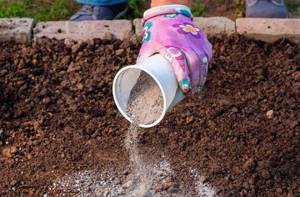
Feeding the garden
In spring, the beds need careful nutrition. To do this, both organic and mineral fertilizers are added to the soil. Well-fertilized soil not only increases productivity, but also strengthens plant immunity to disease.
The basis of spring feeding is nitrogen. It is this that gives strength to the growth of the above-ground parts of plants. Potassium and phosphorus are no less important, and ready-made industrial fertilizers contain all three elements in optimal ratios.
Organic matter is added to the soil in advance - 3-4 weeks before planting crops. Minerals are added just before planting or when digging the beds.
Recommended dosages for soil fertilization:
- manure and compost - 10 liters per 1 square meter of garden;
- nitrogen fertilizers - 30 g per 1 square meter;
- wood ash - 250 g per 1 square meter;
- phosphate mixtures - 25 g per 1 square meter;
- potassium mixtures - 20 g per 1 square meter.
Organic fertilizers
The most popular fertilizer in rural areas is organic. For many gardeners, fertilizer is available free of charge, and it works no worse than store-bought preparations.
Compost
Effective fertilizer is made from decomposed organic waste. The process of rotting occurs in a pit or a pile fenced with shields. To prepare compost, tops of garden crops, weeds, sawdust, leaves from trees, and any food waste are used. Rapid decomposition of organic matter occurs at a temperature of +40°C.
Properly prepared compost can replace mineral fertilizers. To do this, organic matter is not simply thrown chaotically into a heap, but wet and dry layers are alternated. Succulent vegetation is mixed with sawdust or dry leaves. Complete nutrients are provided by adding bird droppings or fresh manure from pets. Phosphorus flour will help enrich organic matter with microelements. For 100 kg of rotting waste, add 2 kg of the substance. Peat gives good results, but it forms an acidic environment. Wood ash will help restore balance.
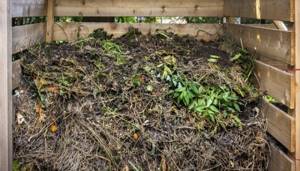
Advice! To speed up decay, each layer of organic waste is sprinkled with earth. In hot, dry summers, the pile is watered, but the water should not stand in a puddle. A film shelter will help retain moisture and maintain optimal temperature.
Manure
Organics are obtained from used pet bedding. The basis is fresh manure mixed with straw, grass or wood shavings. The fertilizer is rich in nitrogen, phosphorus, potassium and other useful substances. To prepare manure, the dirty litter is piled up and covered with plastic wrap on top. The rotting process lasts at least 1 year. The finished organic matter is spread over the area with a pitchfork and distributed evenly with a rake.
Attention! Unrotted manure can only be used for warm beds.
Humus
Organic matter includes manure or compost that has been rotted for two or more years. Ready humus is determined by its looseness and earthy smell. The resulting substance is considered a universal fertilizer, suitable for fertilizing, mulching, and adding to holes when planting seedlings.
Bird droppings
In terms of the amount of useful substances, organic matter is ahead of mullein. Clean droppings are highly concentrated and are used only for making compost. When diluted, organic matter is ideal for feeding garden crops, especially tomatoes. The starter is prepared from 1 part of manure and 10 parts of water. The fermented infusion is diluted with water at a ratio of 1:4 and this solution is added to the plants at the root.
Ash
The most beneficial ash for vegetation is obtained by burning young tree branches and straw. The substance is rich in potassium, which helps reduce soil acidity. Ash serves as a good fertilizer for most garden crops, except carrots. Tomatoes, potatoes, and sweet peppers react well to the substance.
Peat
If the site is not located on peat bogs, then this organic matter will have to be purchased. Peat is used to create beautiful lawns. The substance is evenly scattered over the area, crushed with earth, and after a day they begin to sow the seeds. Peat is well suited for mulching the soil, especially around the trunks of three-year-old apple tree seedlings.
Bacterial fertilizers
The drug is mostly used in growing flowers and garden crops. The composition contains living microorganisms that help plants absorb nutrients from the soil. A striking example is humus, but there are also more concentrated preparations. Bacterial fertilizers are applied in the spring to warm soil during sowing of seeds.
Sapropel
The tableted preparation is made from organic deposits at the bottom of a reservoir. Tablets are applied when preparing the soil or during sowing of crops. The drug is covered with earth, otherwise it is useless.
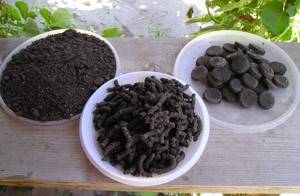
Types of fertilizers and methods of application
Fertilizing the garden and vegetable garden can be done both in spring and autumn. However, professional agronomists claim that spring activities are the most effective.
Organic fertilizers include:
- manure;
- compost;
- peat mixtures;
- straw.
Dates should be determined not by the calendar, but by the actual weather conditions. If in one region everything blooms in April, and in another there is still remnants of snow, then you need to feed the garden at different times. The main signs are meltwater drainage, drying of the soil, swelling of the buds.
For each crop, fertilizing is carried out at different times. trees are fertilized first, bushes follow, and vegetable beds are fed last.
Organic fertilizers
To get the maximum effect, organic matter should be applied correctly:
- manure and compost must mature and rot;
- organic matter application depth - 16-20 cm;
- should not exceed the specified standards per 1 m2;
- Fertilize should be done once every 3-4 years.
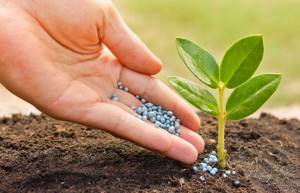
Green manure
If it is not possible to apply fertilizer in the spring, you can use green manure plants. Subsequently, they are crushed and applied to the soil to feed and prevent the proliferation of weeds.
Green manures include:
- cereals;
- cruciferous vegetables;
- legumes;
- buckwheat
Even in the process of growing, they benefit the garden and vegetable garden:
- attract insects that eat pests;
- the growing root part loosens the soil;
- protect other plants from certain diseases.
How to prepare natural fertilizers yourself?
At the end of April, those fertilizers are applied to the ground, which in the future will help the young seedlings, through the development of soil microorganisms, “get on their feet.” All baits are divided, as a rule, into 2 types: mineral and organic. For greater results, you should learn how to combine them correctly.
Organic fertilizers include: compost, bird droppings, wood ash, peat, humus and manure. Many summer residents prepare fertilizers in advance, in the fall, so that from the first days of May they will be fully prepared. Will we tell you? How to make your own natural fertilizers.
- Compost. This is a mixture of tree leaves, vegetable tops, grass clippings without seeds, vegetable and fruit peels, and tea leaves. All this waste is collected in a composter throughout the summer season and periodically watered with slurry or chicken manure solution. Closer to autumn, phosphorus is added to the resulting compost substrate - 1 g. by 20 kg. and lime - 2 gr. by 20 kg., and leave until spring.
- Highly nutritious compost with earthworms living in it. All the same ingredients are collected in a well-ventilated wooden box, straw or paper is added to it - for worms, covered with a layer of earth on top and watered not with manure liquid, but with ordinary water. A day after the contents of the box have been saturated with water, add earthworms to it. Several times a week, it is necessary to add a portion of natural food waste to the box for their proper nutrition and reproduction. This compost is prepared much faster, so you can start forming it from the beginning of March; in 2 months the composition will already have the desired consistency and will be ready for use.
- Ash. Wood ash, obtained by burning cut dry tree branches, is ideal for feeding plants in the spring. You can also add collected dry leaves and mowed grass to the same fire. Avoid contact with plastic, polyethylene, and rubber. Ash is a universal fertilizer that can enrich the soil with a variety of nutrients in quantities sufficient for plants.
- Manure. It is strictly forbidden to add fresh manure to the soil before planting vegetable seedlings - the high content of uric acid in it will cause burns to young shoots and ultimately destroy the plants. Give this fertilizer time and let it rot, then it will become an excellent tool both for the vegetable garden and for fertilizing the garden in the spring. For fruit trees, apply 1 bucket each, for bushes - half.
- Peat. This is organic fertilizer from swamps. It is not a source of nutrients, but it improves the air and water permeability of the soil and enriches it with humus.
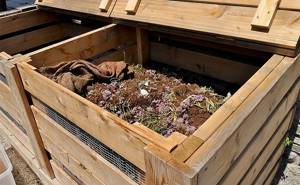
The best fertilizers in the spring at the dacha are dry fertilizers. After the recent melting of snow, the ground is already saturated with water. If you use wet fertilizers during this period, there is a risk of rotting, and therefore fungus. Be careful!
What else do you need to know about crop nutrition?
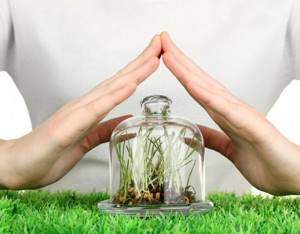
The best feeding is selected according to the growth and development phase of the plant, taking into account the characteristics of the crop.
- Tubers and root vegetables like potassium, so from the early stages of development of radishes, parsnips, carrots, beets, onions and potatoes, it is necessary to provide an increased amount of this element.
- Pumpkins need more nitrogen than others. If possible, the best option for cucumbers and zucchini is to fertilize them with organic fertilizers rather than mineral supplements.
- For nightshades, phosphorus plays an important role. If the weather is cold and the roots of peppers, tomatoes and eggplants cannot absorb phosphorus sufficiently, leaf treatment is carried out.
- Cabbage absorbs the entire NPK complex well, but if the dosage is exceeded, it will delay ripening and increase the risk of disease.
Some farmers believe that fertilizing plants with mineral fertilizers has potential harm, but in practice the problem only arises where the recommendations for use are not followed and the dosage is violated.
As a rule, plants are more likely to experience a lack of important elements than an excess of them. This is due to the lack of protective mechanisms against excessive accumulation of nutrients. Excess nitrogen, which provokes the accumulation of nitrates in the crop, is caused not only by excessive dosage of minerals, but also by the active activity of microorganisms on fallow and virgin soils, and the decomposition of organic matter. The tendency to accumulate nitrates is greater in green crops and root crops. If you provide good watering and lighting, vegetables will not accumulate nitrates. A balanced, regular diet will ensure an abundant, high-quality harvest without harmful elements in the composition.



